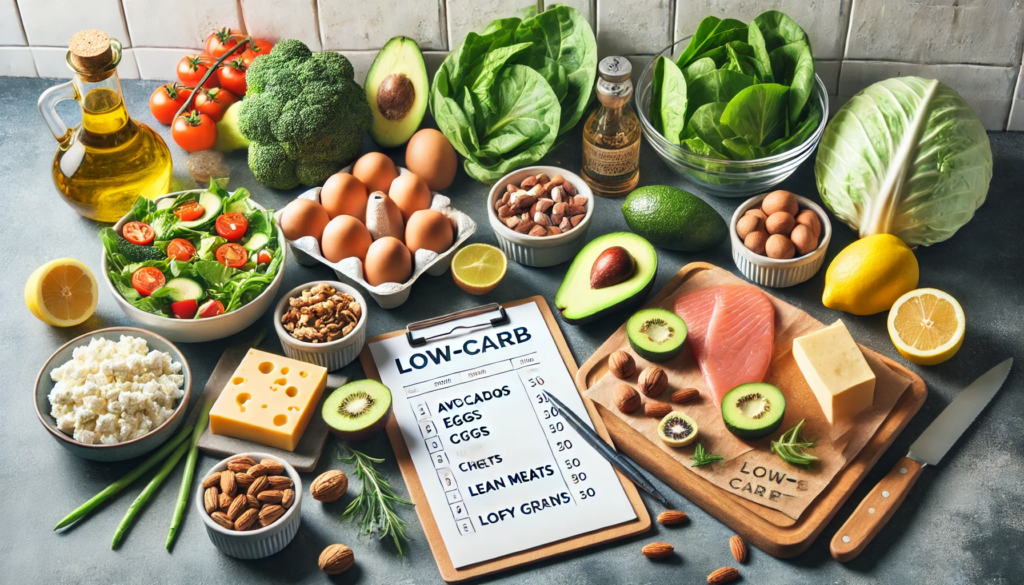
Top 20 Low-Carb Diet Tips for Beginners
Switching to a low-carb diet can be a great way to support weight loss, improve blood sugar levels, and boost overall health. Whether you’re just starting out or looking to optimize your approach, here are the top 20 low-carb diet tips for beginners.
1. Know What to Eat and What to Avoid
Focus on foods like lean meats, fish, eggs, nuts, seeds, healthy fats, and low-carb vegetables. Avoid high-carb foods such as bread, pasta, rice, potatoes, and sugary snacks. Stick to foods that are naturally low in carbohydrates.
2. Start Slowly
Ease into the low-carb lifestyle by gradually reducing carb intake over a few weeks. This helps your body adjust and minimizes the risk of side effects like fatigue and headaches.
3. Prioritize Protein
Include a source of high-quality protein in each meal to help keep you full and support muscle maintenance. Good options include chicken, fish, eggs, and lean cuts of beef.
4. Use Healthy Fats
Replace carbs with healthy fats such as olive oil, avocado oil, butter, and coconut oil. These fats provide energy and help keep you satisfied.
5. Stay Hydrated
Drinking plenty of water is essential on a low-carb diet, as your body will be flushing out excess fluids. Aim for at least 8-10 cups of water daily, and consider adding electrolytes to prevent dehydration.
6. Eat More Fiber
Although you’re cutting back on carbs, it’s important to include fiber-rich foods like leafy greens, broccoli, and flaxseeds. Fiber helps with digestion and keeps you full longer.
7. Monitor Your Carb Intake
Track your daily carb intake to ensure you’re staying within your target range. Use apps like MyFitnessPal or Carb Manager to keep an accurate record.
8. Don’t Fear Low-Carb Vegetables
Low-carb vegetables are packed with essential nutrients and fiber. Include plenty of options like spinach, kale, zucchini, cauliflower, and asparagus in your meals.
9. Avoid Hidden Sugars
Many packaged foods contain hidden sugars and carbs. Read labels carefully, and avoid items with added sugars, syrups, or starches.
10. Plan Your Meals
Meal planning helps you stick to your low-carb goals. Prepare meals in advance using low-carb ingredients to avoid the temptation of high-carb options.
11. Keep Low-Carb Snacks Handy
Having low-carb snacks like nuts, cheese, or hard-boiled eggs on hand can help prevent hunger and curb cravings between meals.
12. Adjust Portion Sizes
While low-carb diets don’t require strict calorie counting, it’s still important to be mindful of portion sizes, especially when consuming higher-calorie foods like nuts and cheese.
13. Choose Low-Carb Beverages
Stick to water, unsweetened tea, or black coffee. Avoid sugary drinks, fruit juices, and sodas that can quickly add up in carbs.
14. Consider Intermittent Fasting
Intermittent fasting can complement a low-carb diet by enhancing fat-burning and simplifying meal planning. Start with a 12-hour fast and gradually increase the fasting window.
15. Be Prepared for the “Low-Carb Flu”
When starting a low-carb diet, you may experience symptoms like fatigue, headaches, and irritability as your body adjusts. This is often referred to as the “low-carb flu.” Stay hydrated, consume enough electrolytes, and be patient—it usually passes within a few days.
16. Choose Quality Sources of Protein
Opt for high-quality protein sources like grass-fed beef, wild-caught fish, and free-range poultry. These options provide more nutrients and healthy fats.
17. Experiment with Low-Carb Recipes
Explore low-carb versions of your favorite dishes. There are many creative ways to make foods like pizza, bread, and desserts using low-carb ingredients.
18. Monitor Your Body’s Response
Pay attention to how your body responds to the diet. If you notice any digestive issues, fatigue, or other symptoms, adjust your carb intake or consult a healthcare professional.
19. Supplement if Needed
Consider supplements like magnesium, potassium, and vitamin D to ensure you’re meeting your nutritional needs. These are especially important on a low-carb diet, as the body loses more electrolytes.
20. Stay Consistent
Consistency is key to success on a low-carb diet. Stick to your plan, track your progress, and make adjustments as needed to stay on track with your goals.
Conclusion
Starting a low-carb diet can be a great way to improve health and manage weight, but it’s important to do it right. By following these top 20 tips, you can ease into the lifestyle safely and effectively. Focus on nutrient-dense foods, stay hydrated, and listen to your body to ensure a successful low-carb journey.
FAQ: Low-Carb Diet Tips for Beginners
1. What is a low-carb diet?
A low-carb diet focuses on reducing the intake of carbohydrates, such as those found in bread, pasta, and sugary foods. It emphasizes consuming more protein and healthy fats while keeping carbs low, typically under 100 grams per day, depending on individual goals.
2. Is a low-carb diet safe for everyone?
A low-carb diet is generally safe for most people, but it may not be suitable for individuals with certain medical conditions, such as kidney issues or diabetes, without medical supervision. It’s important to consult with a healthcare provider before starting any new diet, especially if you have underlying health conditions.
3. Can I eat fruits on a low-carb diet?
Yes, but choose low-carb fruits like berries (strawberries, blueberries, raspberries) and avoid high-carb fruits like bananas, apples, and grapes. Berries provide essential nutrients and fiber without significantly increasing carb intake.
4. What are the common side effects of starting a low-carb diet?
Common side effects when starting a low-carb diet may include fatigue, headaches, irritability, and digestive changes, often referred to as the “low-carb flu.” These symptoms usually subside within a few days as the body adapts to using fat for energy.
5. How can I avoid the “low-carb flu”?
To minimize symptoms of the “low-carb flu,” stay hydrated, consume enough electrolytes (sodium, potassium, magnesium), and gradually reduce carbohydrate intake. Adding a pinch of salt to your water or drinking bone broth can help replenish lost electrolytes.
6. Can I exercise while following a low-carb diet?
Yes, you can exercise while on a low-carb diet. While some people may experience reduced energy during the first few weeks, the body will eventually adapt. Low-intensity exercises like walking, yoga, and strength training are great for beginners, while higher-intensity workouts may be added as your energy levels stabilize.











